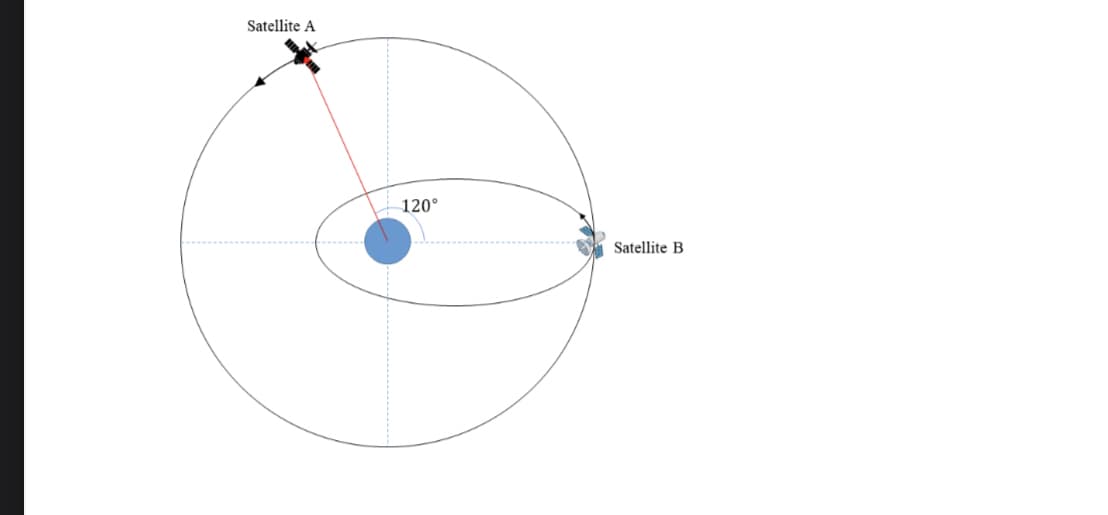Problem 2 The following figure shows two satellites in Earth orbits: Satellite A is in a circular orbit with an altitude of 9,622 km, while Satellite B is in an elliptical orbit with an apogee altitude of 9,622 km. At the instant shown in Figure P2, Satellite B is passing through the apogee while Satellite A is ahead of Satellite B with an angular separation of 120 deg. Determine the perigee altitude of the elliptical orbit so that Satellites A and B occupy the same radial position when Satellite A firstly arrives the apogee point (in other words, Satellites A and B perform a rendezvous maneuver at apogee of satellite B).
Problem 2 The following figure shows two satellites in Earth orbits: Satellite A is in a circular orbit with an altitude of 9,622 km, while Satellite B is in an elliptical orbit with an apogee altitude of 9,622 km. At the instant shown in Figure P2, Satellite B is passing through the apogee while Satellite A is ahead of Satellite B with an angular separation of 120 deg. Determine the perigee altitude of the elliptical orbit so that Satellites A and B occupy the same radial position when Satellite A firstly arrives the apogee point (in other words, Satellites A and B perform a rendezvous maneuver at apogee of satellite B).
Applications and Investigations in Earth Science (9th Edition)
9th Edition
ISBN:9780134746241
Author:Edward J. Tarbuck, Frederick K. Lutgens, Dennis G. Tasa
Publisher:Edward J. Tarbuck, Frederick K. Lutgens, Dennis G. Tasa
Chapter1: The Study Of Minerals
Section: Chapter Questions
Problem 1LR
Related questions
Question

Transcribed Image Text:Problem 2
The following figure shows two satellites in Earth orbits: Satellite A is in a circular
orbit with an altitude of 9,622 km, while Satellite B is in an elliptical orbit with an apogee altitude of
9,622 km. At the instant shown in Figure P2, Satellite B is passing through the apogee while Satellite A is
ahead of Satellite B with an angular separation of 120 deg. Determine the perigee altitude of the elliptical
orbit so that Satellites A and B occupy the same radial position when Satellite A firstly arrives the apogee
point (in other words, Satellites A and B perform a rendezvous maneuver at apogee of satellite B).

Transcribed Image Text:Satellite A
120°
Satellite B
Expert Solution
This question has been solved!
Explore an expertly crafted, step-by-step solution for a thorough understanding of key concepts.
Step by step
Solved in 2 steps with 1 images

Follow-up Questions
Read through expert solutions to related follow-up questions below.
Follow-up Question
This does not answer the question or provide guidance on how to answer it.
Solution
Recommended textbooks for you

Applications and Investigations in Earth Science …
Earth Science
ISBN:
9780134746241
Author:
Edward J. Tarbuck, Frederick K. Lutgens, Dennis G. Tasa
Publisher:
PEARSON

Exercises for Weather & Climate (9th Edition)
Earth Science
ISBN:
9780134041360
Author:
Greg Carbone
Publisher:
PEARSON

Environmental Science
Earth Science
ISBN:
9781260153125
Author:
William P Cunningham Prof., Mary Ann Cunningham Professor
Publisher:
McGraw-Hill Education

Applications and Investigations in Earth Science …
Earth Science
ISBN:
9780134746241
Author:
Edward J. Tarbuck, Frederick K. Lutgens, Dennis G. Tasa
Publisher:
PEARSON

Exercises for Weather & Climate (9th Edition)
Earth Science
ISBN:
9780134041360
Author:
Greg Carbone
Publisher:
PEARSON

Environmental Science
Earth Science
ISBN:
9781260153125
Author:
William P Cunningham Prof., Mary Ann Cunningham Professor
Publisher:
McGraw-Hill Education

Earth Science (15th Edition)
Earth Science
ISBN:
9780134543536
Author:
Edward J. Tarbuck, Frederick K. Lutgens, Dennis G. Tasa
Publisher:
PEARSON

Environmental Science (MindTap Course List)
Earth Science
ISBN:
9781337569613
Author:
G. Tyler Miller, Scott Spoolman
Publisher:
Cengage Learning

Physical Geology
Earth Science
ISBN:
9781259916823
Author:
Plummer, Charles C., CARLSON, Diane H., Hammersley, Lisa
Publisher:
Mcgraw-hill Education,